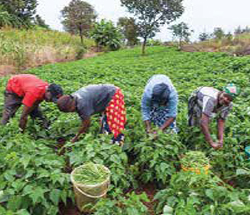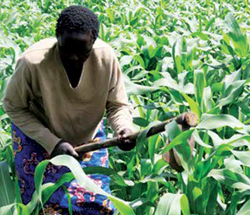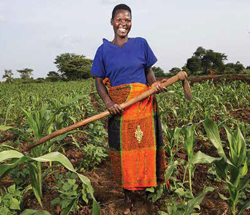Investing in Rural Women Farmers Narrows The Gender Gap In Agriculture
Authors: Jummai O Yila, Scientist – Gender Research Almamy Sylla, Scientific Officer, ICRISAT, WCA Bamako
 The glaring inequality between men and women farmers in the African agricultural sector is alarming evidence that calls for fair, inclusive and sustainable development.
The glaring inequality between men and women farmers in the African agricultural sector is alarming evidence that calls for fair, inclusive and sustainable development.
Gender productivity gaps vary across and even within countries, but recent studies suggest that gender gaps are in the range of 10% to 30%.
Gender gap in agricultural productivity means that crop production is lower than its potential. Closing the gender gap in access to production capitals alone has been estimated to have the potential of lifting 100–150 million people out of hunger, thus resulting in benefits that spread far beyond female farmers. Gender issues in agriculture including access to and control over resources continues to be the underlining factor widening the gap in production between male and female farmers in Africa. Much of the work women do as household providers and agricultural producers is unpaid, making their contribution essentially invisible. Women and female-headed households are disproportionately affected by economic recession and higher food prices and trade policies.
The crucial question becomes, how do women farmers involve in, equitably benefit from and contribute to agriculture development? We cannot overcome these challenges while age-old, ingrained ideas of gender roles deny women’s full participation in decision-making and social and economic development. The stage of intentions, promises and pious hopes should be over; we must now not only act but must all act targeted to challenge and combat gender inequality. Investing in women farmers significantly increases productivity, reduces hunger and nutrition, and improves rural livelihoods for both women and men, and the next generation, partly because women spend their money and their produce differently and save their income by investing in areas such as health, education, social assistance, and child nutrition.
 The Persistence of Gender Inequality is the Reason why we should Challenge it
The Persistence of Gender Inequality is the Reason why we should Challenge it
In order to understand why gender inequality, persist, we need to underscore what gender is. The word gender describes a social construct that ascribes roles, rules (norms), responsibilities, opportunities, power, behavior and what the society considers appropriate for men and women. Though fluid and context-specific, the construction of gender underlines the reason for the persistence of gender inequality experienced differently by men and women. Because gender construction is as old as the human race, so is gender inequality. We are all influenced by gender.
Gender norms (or rules) seem to influence what is appropriate to do in our society. Because of gender, girls and women often have lower social status, less access to resources that should naturally be given or used without applying the gender spectrum. These issues are at the core of the contemporary gender system, which systematically empowers one against the other, consequently producing a bidirectional relationship between gender inequality and development outcomes. While more women farmers in Africa continue to engage in farming, look for and adopt high yielding nutritious and climateresilient crop varieties, they face an array of constraints making full involvement in and contribution to agriculture difficult. One of such is the lack or poor involvement of women farmers in technology development and transfer processes.
“Before women were not interested in growing sorghum but with the arrival of grinkan (improved variety), we started growing for selling to meet our needs. Women are becoming independent of men. The introduction of new varieties brought a change in the relationship between women and men because there are fewer quarrels due to money problems” (by a female sorghum producer in Sikkasou, Mali during FGD in 2019)
Customized interventions to target, reach and empower women cereallegume value chain actors.
Women have far less access than men to input, financial services, land ownership, training and other means of increasing agricultural production and improving family income, nutrition and health. In West and Central Africa, women live in patriarchal societies dominated by stereotypes, and norms. Limited opportunities for innovative technologies hamper rural women’s livelihood prospects and personal development. Through a recent study in three sorghum, pearl millet and groundnut production regions in Mali, about 1000 women farmers, marketers, processors highlighted the most significant constraints and challenges that limit their agricultural productivity, among which access to improved seeds, market linkages, fertilizers are major constraints.
 Gender-sensitive interventions that would create market linkages and increase access to inputs are some of the ways to ease the economic and social burden on women, enable them to benefit from technological development. This is why customized training on behavior change and communication aimed to equip and to build the capacity of women involved in cerealslegumes value chains. Trainings focused on seed production, post-harvest techniques, processing and market linkages are the best way to reach, empower and to alleviate the structural and functional constraints faced by women. A total of 208 women from millet, sorghum and groundnut value chains participated in the trainings in Sikasso, Bougouni, Yanfolila, Koutiala, Kita and Diolila between 26 December 2020 and 06 January 2021.
Gender-sensitive interventions that would create market linkages and increase access to inputs are some of the ways to ease the economic and social burden on women, enable them to benefit from technological development. This is why customized training on behavior change and communication aimed to equip and to build the capacity of women involved in cerealslegumes value chains. Trainings focused on seed production, post-harvest techniques, processing and market linkages are the best way to reach, empower and to alleviate the structural and functional constraints faced by women. A total of 208 women from millet, sorghum and groundnut value chains participated in the trainings in Sikasso, Bougouni, Yanfolila, Koutiala, Kita and Diolila between 26 December 2020 and 06 January 2021.
Need to think about and apply adapted and contextualized responses
Empowering women and combating gender inequalities requires inclusive and transformative approaches that include:
- targeting to ensure that nobody is left behind and no need is forgotten or neglected
- reaching the areas of interest and impactful
- customize interventions that equally benefit women actors of the agricultural value chain
- These actions require urgent interventions to act now by investing more resources and energy in the empowerment of women farmers to facilitate their access to productive resources and their capacity in agricultural innovations for a fairer, more equitable and more balanced world.
There is need to advocate for and alert the world on actions that can reduce gender inequality:
- Go beyond the production stage to support women in each key segment of the agricultural value chain.
- Identify entrepreneurial and paid offfarm options for women in each key node of the agricultural value chain.
- Provide a ‘package’ of support services such as credit, business development training, and transportation services for women farmers.
- Facilitate reducing women’s drudgery and access to inputs, equipment and skills to help them take advantage of innovations, market, and development outcomes.